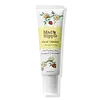What's inside
What's inside
 Key Ingredients
Key Ingredients

 Benefits
Benefits

 Concerns
Concerns

 Ingredients Side-by-side
Ingredients Side-by-side

Aloe Barbadensis Leaf Juice
Skin ConditioningCocos Nucifera Oil
MaskingAlcohol
AntimicrobialCamellia Sinensis Extract
AntioxidantCetearyl Palmitate
EmollientSpirulina Platensis Extract
Skin ProtectingOlea Europaea Fruit Oil
MaskingSodium Hyaluronate
HumectantMelia Azadirachta Extract
Skin ConditioningFragaria Indica Extract
Skin ConditioningSolanum Mauritianum Extract
Skin ConditioningAloe Barbadensis Extract
Skin ConditioningOcimum Sanctum Leaf Extract
Skin ConditioningOcimum Basilicum Extract
AntioxidantCurcuma Longa Root Extract
MaskingCorallina Officinalis Extract
Skin ConditioningTanacetum Annuum Flower Oil
MaskingCarica Papaya Fruit
Skin ConditioningPassiflora Edulis Fruit
Skin ConditioningStearic Acid
CleansingCitric Acid
BufferingNonyl Alcohol
PerfumingAloe Barbadensis Leaf Juice, Cocos Nucifera Oil, Alcohol, Camellia Sinensis Extract, Cetearyl Palmitate, Spirulina Platensis Extract, Olea Europaea Fruit Oil, Sodium Hyaluronate, Melia Azadirachta Extract, Fragaria Indica Extract, Solanum Mauritianum Extract, Aloe Barbadensis Extract, Ocimum Sanctum Leaf Extract, Ocimum Basilicum Extract, Curcuma Longa Root Extract, Corallina Officinalis Extract, Tanacetum Annuum Flower Oil, Carica Papaya Fruit, Passiflora Edulis Fruit, Stearic Acid, Citric Acid, Nonyl Alcohol
Water
Skin ConditioningAloe Barbadensis Leaf
MaskingCetearyl Alcohol
EmollientPalmitoyl Tripeptide-38
Skin ConditioningCarthamus Tinctorius Seed Oil
MaskingGlycerin
HumectantCaprylic/Capric Triglyceride
MaskingNiacinamide
SmoothingPalmitoyl Dipeptide-5 Diaminobutyroyl Hydroxythreonine
Skin ConditioningGlyceryl Stearate
EmollientIsopropyl Palmitate
EmollientPhenethyl Alcohol
MaskingCaprylyl Glycol
EmollientEthylhexylglycerin
Skin ConditioningSodium PCA
HumectantSorbic Acid
PreservativeC10-18 Triglycerides
EmollientXanthan Gum
EmulsifyingArgania Spinosa Kernel Oil
EmollientPotassium Sorbate
PreservativeResveratrol
AntioxidantCocos Nucifera Oil
MaskingCitric Acid
BufferingCamellia Sinensis Leaf Extract
AntimicrobialUbiquinone
AntioxidantEuterpe Oleracea Fruit Extract
Tocopherol
AntioxidantCamellia Sinensis Extract
AntioxidantPunica Granatum Extract
AstringentCitrus Aurantifolia Peel Extract
CleansingWater, Aloe Barbadensis Leaf, Cetearyl Alcohol, Palmitoyl Tripeptide-38, Carthamus Tinctorius Seed Oil, Glycerin, Caprylic/Capric Triglyceride, Niacinamide, Palmitoyl Dipeptide-5 Diaminobutyroyl Hydroxythreonine, Glyceryl Stearate, Isopropyl Palmitate, Phenethyl Alcohol, Caprylyl Glycol, Ethylhexylglycerin, Sodium PCA, Sorbic Acid, C10-18 Triglycerides, Xanthan Gum, Argania Spinosa Kernel Oil, Potassium Sorbate, Resveratrol, Cocos Nucifera Oil, Citric Acid, Camellia Sinensis Leaf Extract, Ubiquinone, Euterpe Oleracea Fruit Extract, Tocopherol, Camellia Sinensis Extract, Punica Granatum Extract, Citrus Aurantifolia Peel Extract
 Reviews
Reviews

Alternatives
Ingredients Explained
These ingredients are found in both products.
Ingredients higher up in an ingredient list are typically present in a larger amount.
Camellia Sinensis Extract is from the oil in tea plant leaves. The leaves give us various types of tea: green, black, oolong, and white.
Camellia Sinensis leaves have many benefits. It contains polyphenols, a strong antioxidant. Antioxidants help fight off free-radical molecules that damage skin cells. The antioxidants in green tea neutralize free-radicals from the sun. This gives the skin some extra UV protection, but should not replace sunscreen.
Many components of tea have anti-inflammatory and antimicrobial properties. Polyphenols and L-theanine help soothe the skin and reduce irritation. L-theanine is an amino acid that makes up most of the amino acids found in tea leaves. The caffeine in Camellia Sinensis Leaf Extract helps calm inflamed blood vessels.
Tea leaves also contain Vitamin Bs, linoleic acid, magnesium, calcium, iron, and zinc.
Research has shown both drinking Camellia Sinensis Leaf Tea and applying it to the skin can help boost skin elasticity and hydration. Studies also show using tea extract may reduce sebum, or oil, production.
Learn more about Camellia Sinensis ExtractCitric Acid is an alpha hydroxy acid (AHA) naturally found in citrus fruits like oranges, lemons, and limes.
Like other AHAs, citric acid can exfoliate skin by breaking down the bonds that hold dead skin cells together. This helps reveal smoother and brighter skin underneath.
However, this exfoliating effect only happens at high concentrations (20%) which can be hard to find in cosmetic products.
Due to this, citric acid is usually included in small amounts as a pH adjuster. This helps keep products slightly more acidic and compatible with skin's natural pH.
In skincare formulas, citric acid can:
While it can provide some skin benefits, research shows lactic acid and glycolic acid are generally more effective and less irritating exfoliants.
Most citric acid used in skincare today is made by fermenting sugars (usually from molasses). This synthetic version is identical to the natural citrus form but easier to stabilize and use in formulations.
Read more about some other popular AHA's here:
Learn more about Citric AcidCocos Nucifera Oil is obtained from the kernels of the coconut fruit. In other words, this is coconut oil.
Coconut Oil is rich in fatty acids with lauric acid making up the majority of these. It also contains linoleic acid. Due to this high fatty acid content, coconut oil helps trap moisture and soften skin.
Despite being antibacterial, coconut oil may not be great for acne-prone skin. It is comedogenic and may clog pores. This ingredient may not be safe for malassezia or fungal acne.
Note: Coconut Oil should not replace your sunscreen for UV protection. Studies show it only blocks about 20% of UV.
This oil is non-volatile and has a light scent.
The term 'fragrance' is not regulated in many countries. In many cases, it is up to the brand to define this term. For instance, many brands choose to label themselves as "fragrance-free" because they are not using synthetic fragrances. However, their products may still contain ingredients such as essential oils that are considered a fragrance.
Learn more about Cocos Nucifera Oil